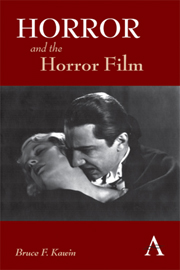6 - Humans
from Part II - Subgenres: The Book of Monsters
Summary
People can behave like monsters. And human monsters can die.
Human aberrations, violators of deep moral codes, icons of disturbed psychology, perpetrators of atrocities, followers of certain cults, outragers of the body, mad scientists, mortal slashers, torturers, ghouls and cannibals have all been called human monsters, even if most of them have normal bodies. Though not a literal monster, a human can fulfill the role of a monster, which is to incarnate and focus the horror, and can function in the film's structure exactly as a monster would. Although it has often been said—most rigorously by Carroll—that horror requires an inhuman monster and that something impossible or fantastic has to be associated with it, it is clear that a picture like The Texas Chain Saw Massacre is a horror film, for it deliberately, atmospherically and painfully puts horrors on show, even if they are credible horrors performed by humans. It also contains such horror icons as Leatherface's mask—doubtless an influence, with Halloween, on Friday the 13th Part III, though the mask can be traced back at least to The Cat and the Canary and indicates Texas Chain Saw's participation in the genre's traditions. The repulsive nature of such an icon is probed further when a mask is made from a freshly carved-off face in The Texas Chainsaw Massacre 2 (Tobe Hooper, 1986, US).
- Type
- Chapter
- Information
- Horror and the Horror Film , pp. 152 - 196Publisher: Anthem PressPrint publication year: 2012

